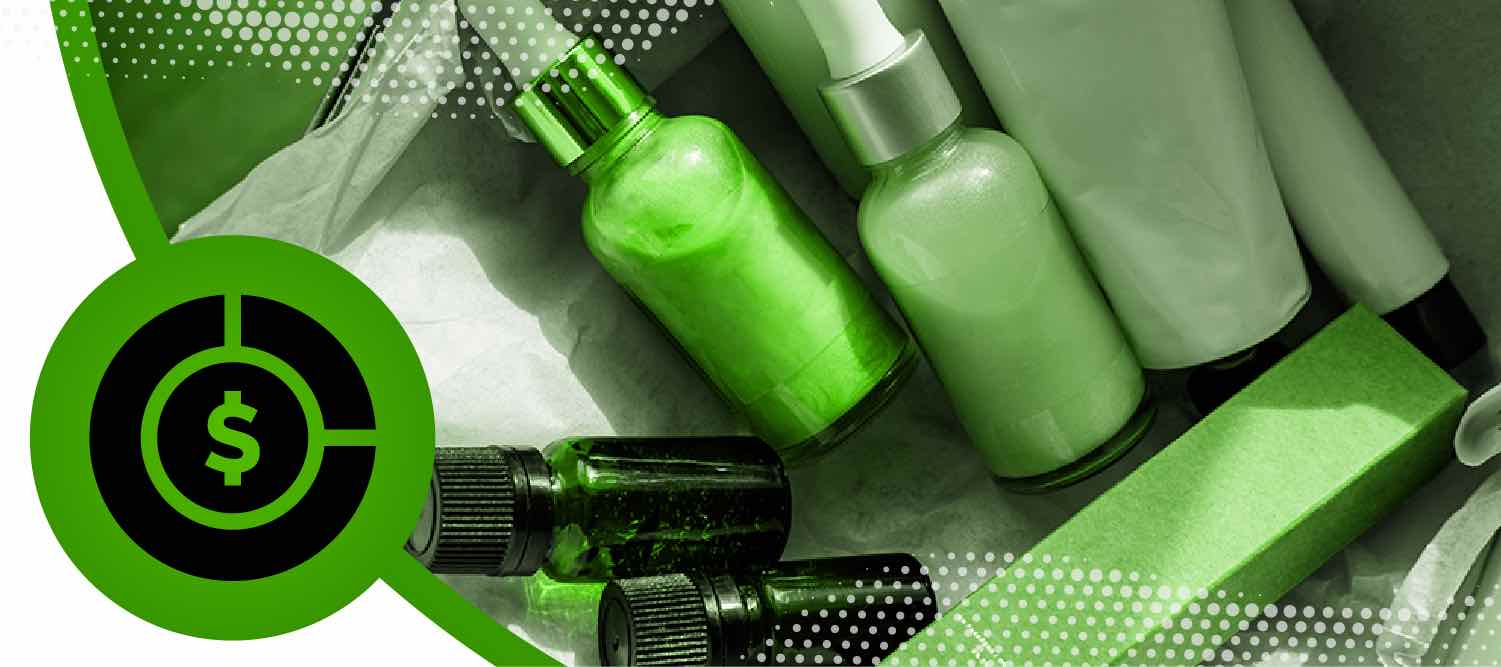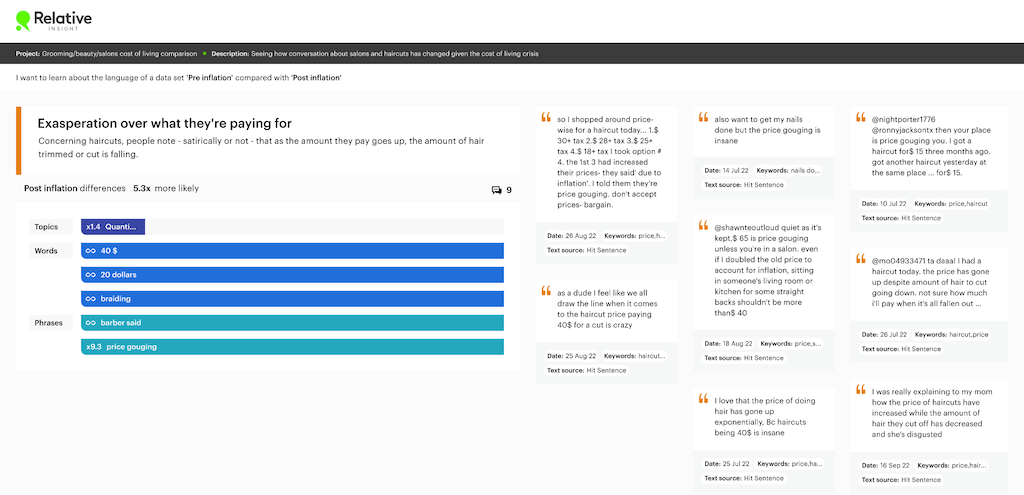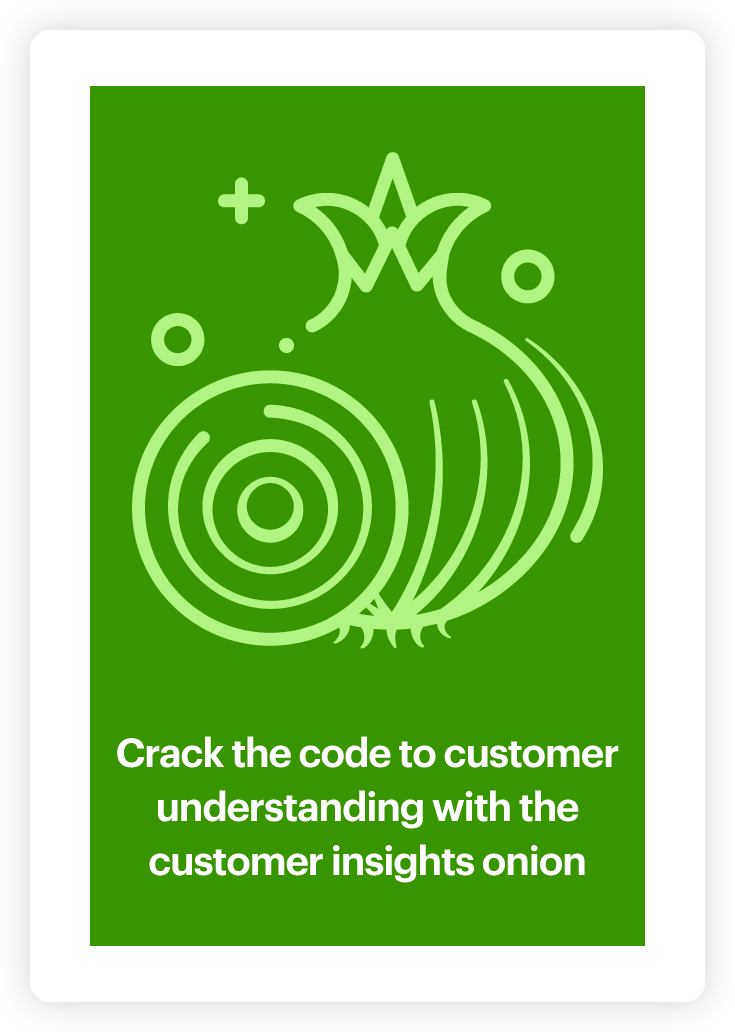Consumer research into inflation’s impact on hair and beauty salons

After suffering badly from enforced closures through the pandemic, spiraling inflation has put hair and beauty salons back in the crosshairs. With rising prices impacting spending, will salon owners need to take a haircut?
While many can’t live without haircuts and beauty glow-ups, this need will be tested in the coming months. Will customers forego these treatments to save money, or will they prioritize looking their best?
To find out, we used a social listening tool to gather conversations where people talked about both salon treatments and their cost/the impact of inflation. We took these discussions from two 90-day periods: February to April (as inflation started to become an issue) and August to October (after price rises had set in). Once we had the data, we uploaded both to our text analytics platform.
Relative Insight Explore uncovers customer insights found within text by comparing multiple data sets and pinpointing the differences between them. Our consumer research tool highlights the nuances contained in text data. In this example, what appear to be simple complaints about the price of salon treatments actually contain valuable, actionable insights into consumer sentiment.
Are we likely to see more DIY haircuts and drug store stick-on nails? Or do salons make the cut for consumers?
Inflation’s impact on hair and beauty salons: Nasty surprises and beauty treatments dominate early-year discussions
As inflation began to have an impact earlier this year, our consumer research highlighted people’s shock at the rising cost of hair and beauty sessions.
Discussions were 3.0x more likely to include words and emojis relating to ‘surprise’ at price rises, with consumers often using the ‘🥴’ emoji to demonstrate their astonishment. Emoji use also extended to ‘😂’, sarcastically illustrating their disbelief at what haircuts, manicures and pedicures cost.
“That time of the year when ur haircut price doubles 🥴”
“Every time I go to the nail salon it’s a new price increase for gel 😂”
Customers were also infinitely more likely to use the word ‘silence’ – this means the word didn’t appear in the other data set. Much of the usage consisted of consumers recounting how they’d fallen silent when the salon had told them the price.

Beauty treatments were more likely to appear in conversations at the start of the year. The phrase ‘gel mani’ was 14.0x more likely to appear, while consumers also talked about getting a ‘mani’ (1.4x), new ‘lashes’ (2.0x) and ‘nails’ (1.3x) done more often.
While most people complained about the rise in prices, other aspects of the conversation focused on advice. One of the main pieces of advice was that others can save money and almost replicate salon nails by using stick-on products – illustrated by the word ‘glue’ appearing 8.5x.
“Check those out! I think my sister uses the glue-ons too. She seems to like them. ☺ she was one of those people getting her nails done at least monthly for a long time but I think she finally decided the cost, when added up, was just too high for her lifestyle.“
Inflation’s impact on hair and beauty salons: Consumers now have inflation fatigue and focus on haircare
After a few months of rising prices, consumer discussions have changed drastically. While people initially greeted the impact of inflation with dark humor and a roll of the eyes, now they’re getting angry and demanding action.
However, for hair salons, these rants come with a silver lining. Our consumer analysis found that people are listing ‘haircuts’ and ‘hairdressers’ alongside other essentials, such as groceries and taxes. People aren’t looking to replicate their lockdown looks; they’re treating haircare as a vital expenditure.
“Carbon tax effects more than fuel, if you go to your dentist, hairdresser, mechanic, groceries, contractors it causes everything to cost more. You think businesses are eating the added costs it costs them to operate? No their not, they up the rates to cover it. Plain and simple.“
Where hair salons need to be careful is their explanation for price increases. While our consumer research indicates that customers are willing to pay higher prices at salons in preference to DIY haircuts, they aren’t happy about it. Conversations have evolved from shock at the prices to questioning why they’re so high.
Specific prices, such as ‘$40′ and ’20 dollars’ are infinitely more likely to appear in discussions between August and October. Dissatisfaction with cost has led consumers to accuse hairdressers of ‘price gouging’, with the phrase appearing 9.3x more over the past 90 days.
“So I shopped around price-wise for a haircut today… 1. $30 + tax 2. $28 + tax 3. $25 + tax 4. $18 + tax. I took option #4. The 1st 3 had increased their prices – they said ‘due to inflation’. I told them they’re price gouging.“

Inflation’s impact on hair and beauty salons: How hair and beauty salons can use research to adapt
By using text analytics to conduct consumer research, we’ve found mixed fortunes for hair and beauty salons.
Haircare customers have grudgingly accepted having to pay more for their haircuts, treating them as essential. However, as inflation continues to bite, they’re starting the question the rationale behind price increases – rather than just being shocked by it. Hair salons raising their prices should be able to justify the increases, otherwise, customers may begin to vote with their feet.
Beauty salons should be more concerned. While consumers aren’t currently complaining about their prices, this could be because they’re not paying them. When this is paired with conversations from early 2022 offering advice about replicating salon treatments, customers could be resorting to DIY beauty regimes with prices so high. In that case, beauty salons need to highlight why their treatments are worth the money when compared with the band-aid beauty solutions customers may be attempting.
These findings on inflation’s impact on hair and beauty salons would be almost impossible to discern by manually analyzing social media conversations. By highlighting the nuances in how people are discussing price rises in hair and beauty salons, our text analysis platform offers market research insights that can help firms to optimize their offerings through challenging times.
